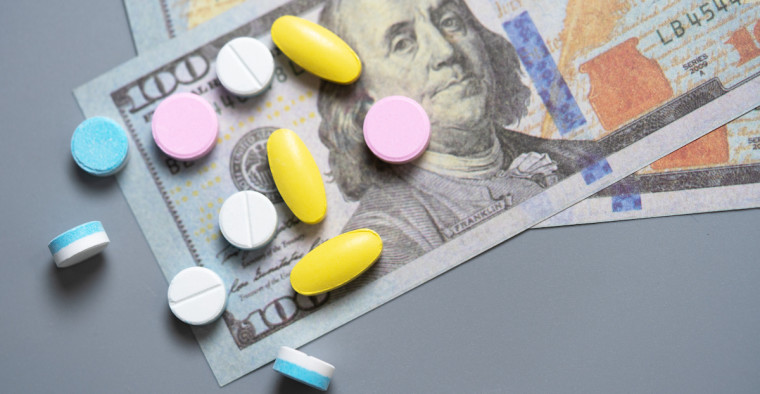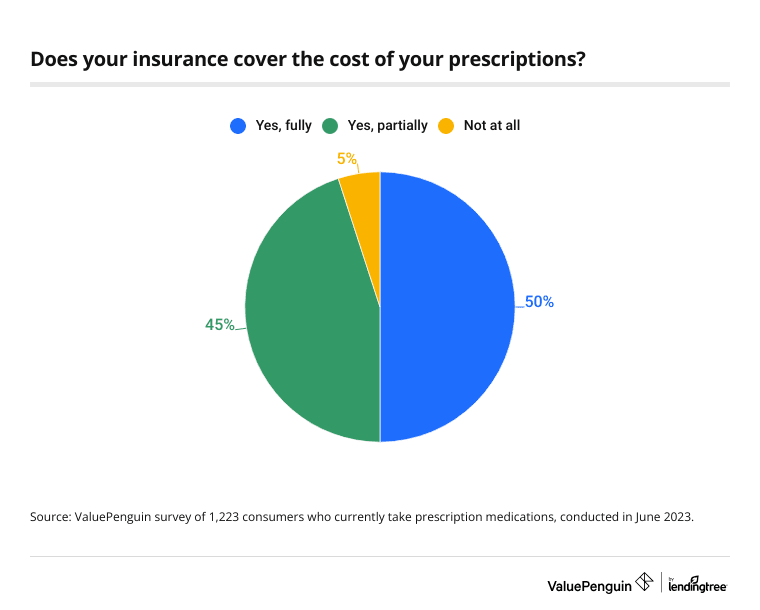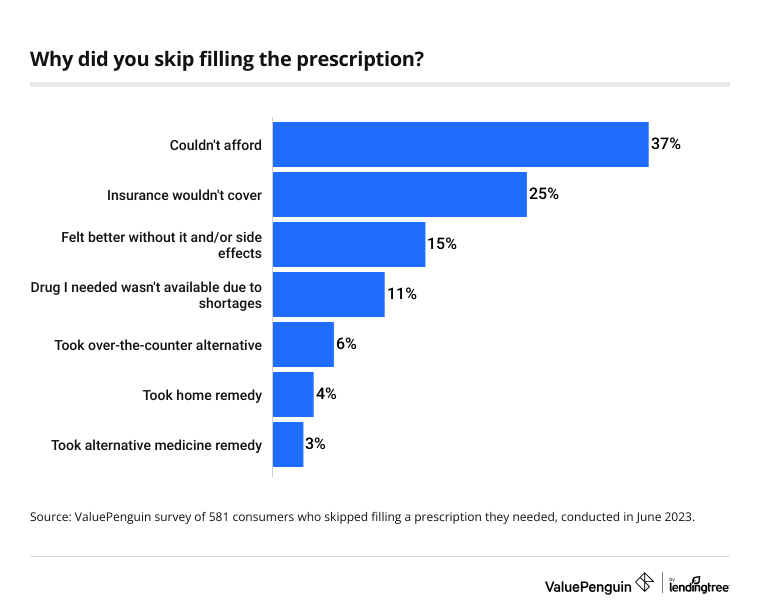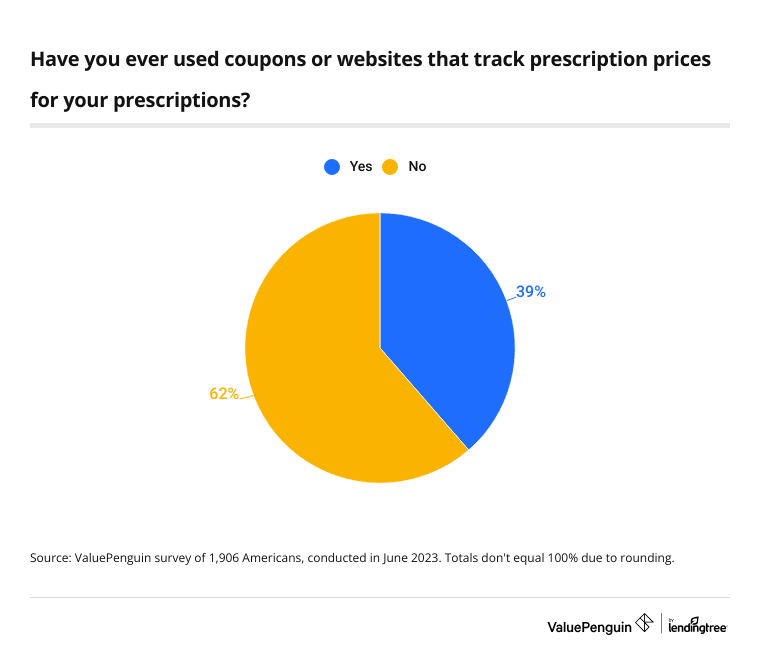Health Insurance
31% of Americans Paying for Prescriptions Say They’re a Financial Strain, but Many Don’t Take Advantage of Ways To Lower Costs

With food prices remaining high and housing costs ever-expensive, simply existing can take a major financial toll.
That’s particularly true for Americans who need medication. According to the latest ValuePenguin survey of more than 1,900 Americans, 31% of consumers who pay for at least a portion of their prescriptions say those expenses are a financial strain. And that figure rises to 41% among those with ongoing major medical issues.
Here’s what else we found.
On this page
- Key findings
- Americans who pay for at least a portion of their prescriptions say they’re a financial strain
- 17% have gone into debt to afford their family’s prescriptions
- Nearly a third of Americans have skipped filling a prescription because they couldn’t afford it
- Online pharmacies help save money, but only 31% have used them
- Majority of Americans aren’t using common cost-saving measures
- Struggling to afford medication? Here’s what experts recommend
- Methodology
Key findings
- Out-of-pocket medication expenses are straining some consumers’ wallets — especially those with ongoing medical issues. Of the 64% of Americans who take prescription medication, just 50% say health insurance fully covers related costs. Among those who have to pay at least a portion of their medication costs, 31% view the expense as a financial strain. That figure rises to 41% among those with ongoing major medical issues.
- The Affordable Care Act made health insurance more accessible, but health plans don’t always cover full prescription costs. Of those without full prescription coverage, 90% say their insurance covers part of their prescription costs, leaving 10% on the hook to pay retail prices. Across all Americans, 17% have gone into debt to afford their family’s prescriptions, and that rises to 28% among those with ongoing major medical issues.
- Those who struggle with the cost of prescriptions are forced to make difficult financial and personal health decisions. Almost a third (31%) of Americans have skipped filling a prescription, mainly because they couldn’t afford it (37%) or their insurance wouldn’t cover the cost (25%).
- The good news is that there are strategies and tactics to lower the cost of prescriptions, but the majority of Americans are unaware. Just 31% of Americans have used an online pharmacy. But those who have felt the benefits, with 78% saying their insurance covered it and 81% saying it was cheaper. Additionally, just 33% of Americans have switched pharmacies to take advantage of lower costs.
- Aside from using a different pharmacy, there are other ways Americans paying for prescriptions can save. 79% of Americans without full coverage haven’t negotiated the cost of a medication with their insurer, 75% haven’t contacted the drug manufacturer to ask about pharmaceutical assistance programs and 56% have never asked their health care provider for alternative prescriptions covered by insurance. Additionally, 62% of Americans have never used coupons to save on prescription costs or websites to track prices.
Americans who pay for at least a portion of their prescriptions say they’re a financial strain
Of the 64% of Americans who take prescription medication, just 50% say insurance covers the full cost.

According to ValuePenguin health insurance expert Divya Sangameshwar, that’s not surprising — particularly because another ValuePenguin study found that 55.7% of American private sector workers were enrolled in high-deductible health plans (HDHPs) in 2021. That’s the highest on record (dating to 2012) and the eighth straight yearly increase.
"Americans enrolled in HDHPs have to pay higher out-of-pocket costs with a coinsurance percentage for prescriptions," she says. "This underscores the importance of looking at more than just the monthly premium when picking a health plan — especially if you need pricey prescriptions."
By age group, millennials ages 27 to 42 are the most likely to say their insurance fully covers the cost of their medication at 58%. That compares with:
- 52% of Gen Zers ages 18 to 26
- 50% of Gen Xers ages 43 to 58
- 40% of baby boomers ages 59 to 77
Perhaps due to Medicaid qualifications, those making less than $35,000 are the most likely income group to say their prescription costs are fully covered at 61%. Comparatively, just 41% of those making between $50,000 and $74,999 say similarly — the lowest by income group. Additionally, men (57%) are more likely to say their medications are fully covered than women (44%).
For those who have to pay at least part of their prescriptions, those costs are often a burden. Among this group, 31% say paying for their medication is a financial strain. That’s particularly true among millennials at 43%. Meanwhile, just 19% of baby boomers say similarly.
Those with ongoing major medical issues (41%) are more likely to say medication costs are a financial strain. On the other hand, 27% of those with some minor health issues and 19% of those with no medical issues feel that financial strain.
How much, exactly, are consumers spending on medication? While the majority (69%) say they spend $99 or less a month on their prescriptions, over a quarter (26%) say they spend between $100 and $499 monthly. Breaking this down even further:
- One-third (33%) of millennials spend between $100 and $499 a month. Millennials are also twice as likely to spend between $500 and $999 at 11%, versus 5% of all consumers who pay for prescription medications.
- 78% of baby boomers spend $99 or less a month, making them the most likely age group to spend this amount.
- Men (31%) are more likely to spend between $100 and $499 monthly on medications than women (23%).
It’s also worth noting that Americans with major health conditions are less likely to say they only keep their prescription spending in the double digits. Of this group, 54% say they spend $99 or less monthly on medications — significantly less than the 81% of Americans with no health conditions and 71% of Americans with minor health conditions who say similarly.
Majority of Americans rely on prescriptions — regardless of health status
Overall, 64% of Americans have at least one prescription medication, with 39% saying they have multiple. Unsurprisingly, 96% of those with serious or chronic health issues have a prescription (highest of any group) — 79% of whom rely on multiple medications.
Even Americans with minor or no health concerns rely on prescriptions. In fact, 80% of Americans with minor health conditions and 35% of Americans with no health concerns say they have at least one prescription.
But what if those prescriptions aren’t exactly conventional? With diabetic medications like Ozempic increasingly being prescribed for off-label uses like weight loss, it may not be surprising that 23% of Americans say they got a drug prescribed to them for off-label use. That figure’s common among:
- Six-figure earners (37%)
- Americans with kids younger than 18 (35%)
- Millennials (34%)
- Men (28%)
Among the Americans who say they got a drug prescribed to them for off-label use, 73% say their insurer covered its use. Perhaps as a result of this, 83% say they were able to afford their off-label prescription.
17% have gone into debt to afford their family’s prescriptions
Health insurance may be more accessible due to the Affordable Care Act, but health plans don’t always fully cover prescription costs. Of those without full prescription coverage, 90% say their insurer covers part of their prescription costs — but 10% are on the hook to pay full retail prices.
With that burden in mind, it’s worth noting that 17% have gone into debt to afford their family’s prescriptions. That figure rises to 28% among those with children younger than 18 — significantly higher than the 11% of Americans with adult children and 10% of those without children who say similarly.
By health status, those with some ongoing major medical issues (28%) and those with serious or chronic medical issues (24%) are the most likely to go into debt for prescription costs. That compares with 17% of those with minor issues and 12% with no major issues.
Meanwhile, millennials (25%) are the most likely age group to go into debt for family prescription costs. That stacks up against:
- 19% of Gen Zers
- 15% of Gen Xers
- 6% of baby boomers
Additionally, men (23%) are more likely to have taken on prescription debt than women (12%).
Nearly a third of Americans have skipped filling a prescription because they couldn’t afford it
For many Americans, the costs of prescriptions aren’t only a financial burden — sometimes they’re a health burden, too. In fact, 31% of Americans have skipped filling a prescription they needed, mainly because they couldn’t afford it (37%) or their insurance wouldn’t cover the cost (25%).
Although skipping a prescription might seem financially necessary, Sangameshwar says it’s extremely risky.
"Skipping prescriptions can set back the treatment plan your doctor has put in place for you, increase the time it takes for you to feel better and complicate or worsen the condition your medication was intended to treat," she says. "Skipping a prescription may save you money in the short term, but it can cost you a lot more in the long term."

By health status, those with serious or chronic health conditions are the most likely to say they skipped filling a prescription at 45%. That’s followed by those with some ongoing health issues (44%) and those with minor health issues (34%).
Meanwhile, millennials (42%) are the most likely age group to skip filling a prescription. That compares with:
- Gen Xers (30%)
- Gen Zers (26%)
- Baby boomers (16%)
Those with underage children (42%) are significantly more likely to say they’ve skipped a prescription than those without children (25%) and those with children older than 18 (21%). Meanwhile, six-figure earners and those making between $35,000 and $49,999 are the most likely income group to say they’ve skipped filling a medication before at 34% each. In contrast, 26% of those making between $50,000 and $74,999 say similarly.
Online pharmacies help save money, but only 31% have used them
In an increasingly online world, it’s not surprising that many pharmacies now operate digitally, too — but consumers may be wary of them. In fact, just 31% of Americans have used an online pharmacy. That figure’s highest among six-figure earners (53%), parents with children younger than 18 (42%) and men (40%).
By age group, millennials (39%) are most likely to use online pharmacies — significantly higher than the 26% of Gen Xers and baby boomers who say similarly (tying for the next highest age group).
Why aren’t more Americans utilizing online pharmacies? According to Sangameshwar, the hassle of switching and potentially long shipping times may play a role — though the risks of moving to an online pharmacy may also be to blame.
"Americans considering a switch to an online pharmacy should do their due diligence before making the switch," she says. "This includes working with an online pharmacy that requires a doctor’s prescription for medications, has a physical address and phone number in the U.S., is licensed to operate in the state they’re in and has a licensed pharmacist on staff to answer questions. Your insurer would have this information, so a good place to start your research would be with them. Your insurer will also help you find out if the online pharmacy is in their network."
Though online pharmacies can be risky, the Food and Drug Administration (FDA) regularly investigates online pharmacies that engage in dangerous practices — such as shipping counterfeit medications — and has published a list of pharmacies they’ve found to be questionable. Sangameshwar recommends that Americans considering the switch should check with the FDA to see if the online pharmacy they’re considering has been flagged for unsafe practices.
Still, those who have utilized online pharmacies say they’ve noticed the benefits. Of those who’ve taken their prescriptions to online pharmacists, 78% say their insurance covered it. That’s particularly true among baby boomers (83%) and six-figure earners (83%). Meanwhile, 81% say it was cheaper, a figure that’s high among six-figure earners (86%) and adults with underage children (86%). It’s also worth noting that men (86%) are significantly more likely to say online pharmacy costs are cheaper than women (74%).
This comes as just 33% of Americans say they’ve switched pharmacies to take advantage of lower costs (though more on that below).
Majority of Americans aren’t using common cost-saving measures
Paying for medications may be a financial burden, but there are many ways to cut costs — though the majority of Americans haven’t explored most cost-cutting measures. In fact, 79% of Americans without full coverage haven’t negotiated the cost of a prescription with their insurer. Meanwhile, 75% haven’t contacted the drug manufacturer about pharmaceutical assistance programs and 56% have never asked their health care provider for alternative prescriptions covered by their insurance.
Additionally, 62% of Americans have never used coupons to save on prescription costs or websites to track related costs.

By age group, millennials who pay for their prescriptions are most likely to try cutting costs. They’re particularly likely to ask their health care provider for alternative medications that their insurance covers (53%) and negotiate the cost of prescriptions with their insurer (38%). Millennials overall (regardless of whether they pay for their prescriptions) are also most likely to use coupons, at 49%.
Men who pay for their prescriptions are also more likely to employ cost-saving strategies than women — particularly when it comes to asking their health care provider for alternative prescriptions that their insurance covers (at 50% versus 40%), asking the drug manufacturer about pharmaceutical assistance programs (32% versus 20%) and negotiating the cost of prescriptions with their insurer (30% versus 16%). Across all Americans, men are also more likely to use medication coupons than women, at 42% versus 36%.
Meanwhile, those with kids younger than 18 who pay for their prescriptions are particularly likely to ask their health care provider for alternatives (57%) and ask the drug manufacturer about pharmaceutical assistance programs (39%).
While Americans with major and serious health conditions are more likely to be aware of strategies to save money on their prescriptions, the levels of awareness vary by the type of strategies they employ — and, Sangameshwar says, aren’t as high as they should be. To break that down:
- 55% of Americans with major ongoing health conditions who pay for their prescriptions have asked their health care providers for alternatives to save costs.
- 28% of Americans with major ongoing health conditions who pay for their prescriptions have negotiated related costs with their insurer.
- 28% of Americans with major ongoing health conditions who pay for their prescription have contacted the manufacturer to ask about pharmaceutical assistance programs.
- Regardless of whether they pay for a prescription, 48% of Americans with serious and chronic health conditions have used coupons to save on prescription costs.
Struggling to afford medication? Here’s what experts recommend
Medication is expensive, but skipping a prescription — while an understandable thought — is often unnecessarily dangerous.
"High prescription drug prices are forcing many Americans to make difficult and sometimes troubling choices, such as skipping their prescriptions because they can’t afford them," Sangameshwar says. "But that’s a drastic and dangerous choice, especially when Americans can employ many other strategies to reduce the cost of their prescriptions."
To help lower costs, she recommends the following:
- Talk to your pharmacist and insurer. For unaffordable medications, ask your pharmacist and insurer if there’s a lower-cost alternative or a generic medication that works similarly.
- Talk to your doctor. Review suggestions from your pharmacist and insurer with your doctor to find out if switching to these lower-cost drugs makes sense for your medical needs. It’s also important to review medications with your physicians to see if you need them or if you can stop taking them if your health has improved.
- Shop around for pharmacies. "A good example of this includes online pharmacies, where most Americans in our survey say they’ve saved," Sangameshwar says. "Similarly, big-box retail and wholesale club stores also offer deep discounts on certain generic prescription medications."
- Carefully read the prescription drug coverage section when shopping for a health insurance plan. "If you have a choice between different health insurance plans, check if each plan you’re considering will cover your prescriptions and see how much you’ll need to pay," she says. "It’s important to look beyond monthly premium costs when choosing a health plan."
- Other strategies, like negotiating the cost of your prescriptions with your insurer or reaching out to the drug company for assistance, are also available if all the above methods don’t work. "Employing any one or a combination of these strategies will save you money — and they’re better and safer options than skipping your prescription," Sangameshwar says. "You are your own best advocate, so don’t hesitate to do your research, ask questions and push for better options that work for your health and finances."
Methodology
ValuePenguin commissioned QuestionPro to conduct an online survey of 1,906 U.S. consumers ages 18 to 77 from June 26-27, 2023. The survey was administered using a nonprobability-based sample, and quotas were used to ensure the sample base represented the overall population. Researchers reviewed all responses for quality control.
We defined generations as the following ages in 2023:
- Generation Z: 18 to 26
- Millennial: 27 to 42
- Generation X: 43 to 58
- Baby boomer: 59 to 77